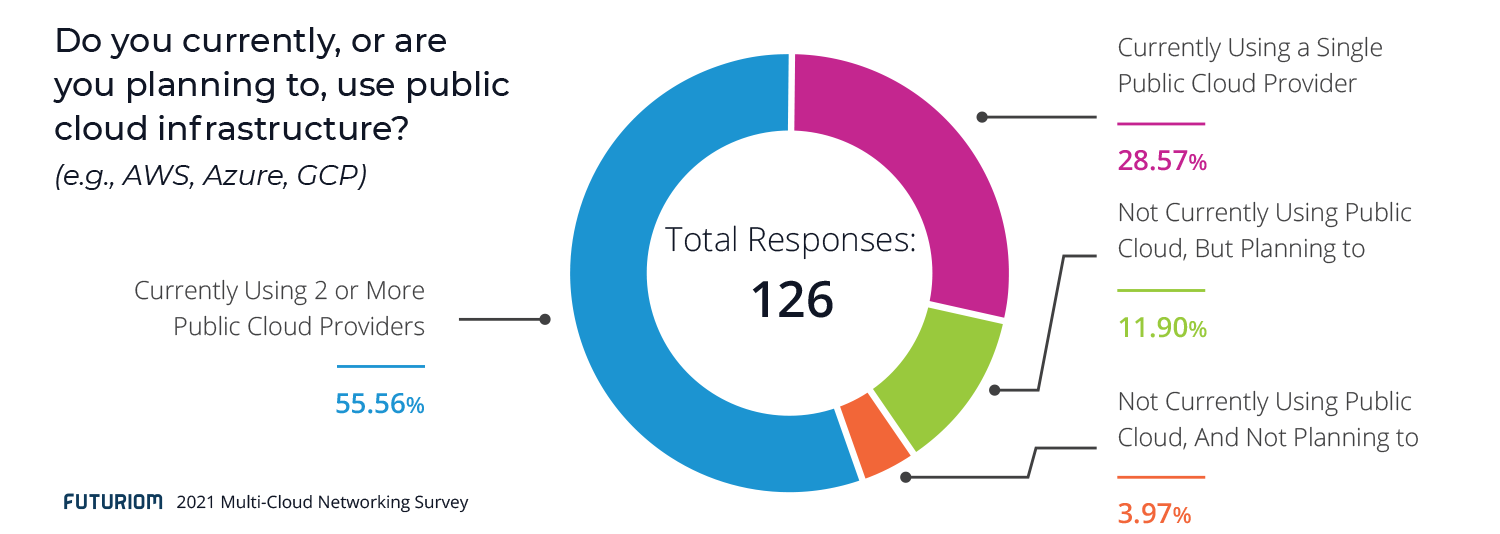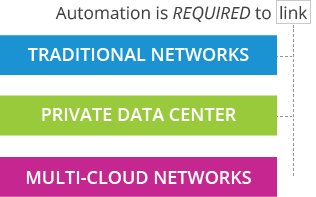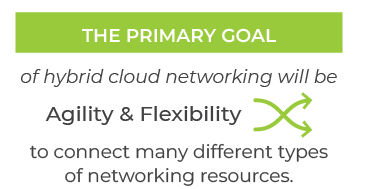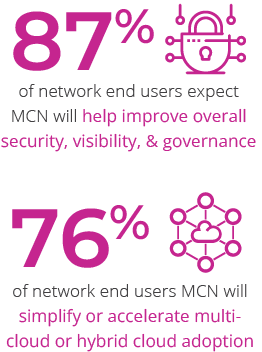Overview
Organizations have accelerated their move to the cloud in a global drive toward digital transformation, which requires more flexible, on-demand information technology (IT) services. But these organizations aren’t just interested in using one cloud – they would like to utilize many cloud services, resources, and platforms. This will have large implications for networking and communications infrastructure for many decades to come.
There are many drivers of the move to cloud: digital transformation projects, hybrid work arrangements, automation, and data analytics efforts enabled by cloud-based artificial Intelligence (AI) and machine learning (ML), among others. Using hybrid and multi-cloud approaches also offers the opportunity to provide flexibility, scale, and lower cloud costs by avoiding lock-in to specific cloud service providers.

Digital transformation is a top driver for multi-cloud , with over 90% of large enterprises citing they have adopted multiple cloud technologies.
Hashicorp “State of Cloud Strategy” Survey
The migration to using multiple clouds and hybrid cloud is likely in the early stages of a long-term cycle. In a recent State of Cloud Strategy survey by cloud technology provider HashiCorp, 34% of respondents cited digital transformation as a top driver for multi-cloud adoption. For example, 90% of businesses with more than 5,000 employees said they have adopted multi-cloud, and 64% of large-enterprise respondents said multi-cloud has helped achieve their business goals.
The State of Multi-Cloud & Hybrid Cloud Adoption
The cloud-enabled transformation is occurring rapidly but also has a long runway. By most metrics, the cloud has only achieved 10% to 20% of market penetration on an application workload basis. It will require new hybrid and multi-cloud architectures to take advantage of the best cloud resources, wherever they reside. One of the biggest barriers to this multi-cloud transformation is the typical enterprise network, which must be modernized to be able to connect multiple clouds and resources.
In Futuriom’s 2021 Multi-Cloud Networking survey, 120 enterprise networking and IT experts were asked how they view the use of public cloud infrastructure. Of those surveyed, 55.6% use two or more public cloud providers; 28.6% said they use a single public cloud provider. Of the 120 respondents surveyed, only 11.9% said they don’t use a public cloud provider but have plans to, and 4% said they have no plans to use public cloud providers.

The Challenges with Multi-Cloud Adoption & Why Networking Will Be Pivotal
Adopting hybrid and multi-cloud services is not a simple proposition. Cloud infrastructure consists of many different types of platforms and services: software-as-a-service (SaaS) applications, platform-as-a- service (PaaS), and infrastructure-as-a-service (IaaS). These services come in many shapes and sizes, with niche offerings such as business analytics, AI/ML, security services, and Internet of Things (IoT), just to name a few. At the same time, organizations may have traditional enterprise or datacenter resources they would like to utilize or integrate with cloud services.
One of the biggest barriers to the multi-cloud transformation is the typical enterprise network, which must be modernized to be able to connect multiple clouds and resources.
Networks, which are responsible for connecting clouds with applications and carry all the data, will be crucial to these efforts. In many cases, networking will prove to be a major challenge. Most networks have been built with specific environments, or “domains” in mind – for example, for an enterprise branch, a datacenter (private or public), or industrial setting. Connecting these different computing domains or platforms requires a flexible networking infrastructure that can also be managed and monitored to ensure security and compliance.

The next step for the cloud migration is to build more flexible networking platforms that can span the enterprise, datacenter, and public cloud. This networking approach needs to use software and automation to dynamically provision, manage, and integrate management of the networks that can link traditional enterprise networks, private data centers, and public cloud platforms and services.
Integrating Hybrid Cloud Network Infrastructure
In the drive to the cloud, not all organizations are in a position to rip-and-replace what they’ve already built. There are many forms of traditional compute, storage, and networking resources that will need to be integrated into any cloud compute or networking plan.
Networking must adapt to this hybrid and multi-cloud reality while retaining the capability to connect to traditional infrastructure, including routers, switches, and firewalls, which despite cloud remain the lifeblood of connectivity for enterprise IT assets. Networking infrastructure has developed over several decades as waves of computing paradigms have transformed IT organizations. Over the course of time, it has become more challenging to manage this diverse environment spanning legacy enterprise to cloud native.
The networking infrastructure might include a wide variety of technologies and approaches: software-defined networking (SDN) for private or cloud resources; traditional underlay networks, including routers and switches; software-defined wide-area networking (SD-WAN) for enterprise branches; or application-layer cloud networking approaches such as service mesh.

What is the network anymore? It’s not just physical routers and switches. It’s also cloud transit gateways, and traditional enterprise networks. Organizations are going to need a platform that they can automate. They are re-thinking how to move from the silos and domains and build network automation.
Peter Sprygada,
VP Cloud Management, Itential
Take a look at how differing networking systems have evolved, yet still remain vital and in place:
Traditional Networks
Traditional enterprise networking emerged from the LAN/WAN revolution of the 1990s and the 2000s, using standardized technologies such as Ethernet and Internet Protocol (IP) routing in switches and routers to connect enterprise devices as well as private data centers. Many of these devices remain in the majority of installations, running the network.
Cloud Native Networks
Cloud-native implementations introduced new techniques and environments for managing application-layer networking, often referred to as service meshes. The emergence of Kubernetes, which also provides its own networking functions, can also be used to build service meshes. But while these techniques might be highly automated and effective in specific cloud environments, they usually can’t traverse networking domains without interacting with traditional networking devices such as routers and switches.
Virtualized Networks
The boom for both private and public cloud datacenters spawned the need for SDN and virtualization overlays that could be used to drive network automation at scale to connect resources within specific datacenters. These overlay technologies were useful for connecting inside of datacenters, but not necessarily efficient for connecting to the outside world.
SD-WAN
SD-WAN is a modern adaption to the cloud built for enterprise branches. It’s brought a new paradigm to the branch-office routing market and is now evolving to provide additional security features with the emergence of secure access service edge (SASE). But SD-WAN is largely focused on branches – it doesn’t provide a networking platform for connecting all of the devices in an organization to the cloud.
This evolution has left a lot of networking islands, all equipped with their own networking tools, languages, and management systems. They have become more siloed and difficult to integrate than ever before.
The Rise of Multi-Cloud Networking
At the top level, it’s clear there is demand for a new type of infrastructure that can handle the demands of enterprise networks, private datacenters, and public cloud. End users and IT staff are starting investments in multi-cloud networking, which they expect to improve cloud operations. The primary goal of hybrid cloud networking will be agility and flexibility to connect many different types of networking resources. But there are other considerations: security, automation, compliance, and scalability.


Futuriom research with enterprise networking end users shows that these types of concerns are top of mind. Of those surveyed in our recent multi-cloud networking survey, 87% expect MCN will help improve overall security, visibility, and governance.
The survey also reinforced that MCN technology is seen as critical infrastructure to enable multi-cloud and hybrid cloud evolution. When we asked if the arrival of MCN solutions will simplify or accelerate multi-cloud or hybrid cloud adoption, 76% of respondents replied “Yes.” Only 7.5% replied “No,” and 17% weren’t sure.
This means that IT staff and management are looking to invest in hybrid or multi-cloud networking (MCN) technology over time. Of those surveyed, 71% expect to invest modestly or substantially in MCN technology. A smaller percentage, 24%, expect to invest a little bit in test and pilot projects. Only 4% said they have no plans to invest in MCN technology.
Building Blocks of Hybrid Cloud Automation
We’ve established that enterprise end users see networks as key to the delivery of hybrid and multi-cloud environments. The problem is, most networks are not ready to do that. Most networks live among silos and do not talk to each other well.
Existing references to network automation are often focused on one silo – enterprise, datacenter, or cloud – and aren’t useful in automating all networks. A new kind of network automation is needed to coordinate the entire realm of networks: service mesh, overlay networks, and traditional underlays.
So how do we arrive there? The answer will take its cue from the origins of the cloud, where automation was driven by standardization, application programming interfaces (APIs), and software orchestration.
It’s crucial that multi-cloud and hybrid cloud networking be driven by software automation. Not only do networking managers need a better way to connect and manage cloud networks, but builders of cloud applications and members of DevOps teams want to build networking and security into their software deployments.
The good news is that many of the software building blocks are already available to integrate the wide variety of networking platforms, from traditional enterprise to the cloud.
The Key Elements Needed for Automation of Hybrid Networks:
Networking Orchestration & Configuration Standards

Industry standards and data models such as NETCONF/YANG, OpenConfig, or APIs provided by original equipment manufacturers (OEMs) and software providers now make it easier for networks to talk to one another. These tools enable network automation and orchestration by providing standardized software models that enable networking hardware to be programmed with code – a movement known as infrastructure as code.
Software Overlays & Service Mesh

Networking software overlays, which can include technologies such as IPsec and secure virtual tunnels, enable applications and networks to be segmented using software only, rather than requiring separate logical hardware-based networks. But overlays are sometimes just a band-aid. MCN will take this a step further by enabling deeper management, segmentation, security, and control of cloud networks.
APIs

APIs are the standard software hooks provided by individual networking vendors and OEMs. They have been a crucial element of datacenter and SD-WAN virtualization, and they will become increasingly important to automate hybrid cloud networking. APIs enable any platform, hardware or software, to expose software connectivity in the form of code, enabling automation. Data APIs can be used to provide a steady stream of network telemetry and state information. The use of HTTP and Web software interfaces such as JavaScript Object Notation (JSON) have been crucial to enable the development of new network management tools. But there’s another innovation coming too:
Integration with L2/L3 Networking Fabric

The L2/L3 networking fabric, often referred to as the “underlay” because it directly operates the control plane of the networking hardware, will remain important because a network can’t exist without hardware or underlay. However, with the rise of software overlays, some engineering factions believe the L2/L3 will become less important as overlay technologies and infrastructure as code becomes more popular. One thing that is clear from our survey discussion and survey results is that integration with L2/L3 networks and cloud networking is increasingly important to the end users.
Infrastructure as Code

Tools coming out of the cloud world, such as Kubernetes and HashiCorp’s Terraform, are enabling network elements to be managed and orchestrated directly from within the code of an application. This will make network programmability part of the cloud software fabric, paving the way for integrated, hybrid cloud networking.
Networking-as-a-Service (NaaS)

NaaS as a concept is gathering steam. Think of it as buying a pre-built networking service directly from the cloud rather than building a new network. As cloud infrastructure expands, NaaS implementations will grow in importance as enterprises and other organizations, including service providers, will have opportunities to leverage cloud infrastructure without building new networks themselves..
These building blocks are useful in constructing a hybrid or multi-cloud network, but not everybody wants to do that themselves. What many organizations are looking for is a platform that can automate the process of building an integrated, hybrid cloud network. This paves the way for a hybrid automation platform.
Realizing the Benefits of Automating Hybrid Networks with an Integrated Platform
Imagine managing physical, virtual, and cloud infrastructure with one platform – a hybrid cloud networking platform. Using APIs, networking standards, and software automation, the hybrid automation platform can tie together any networking domain, whether it’s traditional networking infrastructure or software-defined wide-area networking (SD-WAN) branches. Itential has already built its own Automation Platform that is being used in the real world by organizations who didn’t want to build or maintain their own networking code. Here are some examples:

S&P Global uses the Itential Automation Platform to automate and orchestrate both traditional and emerging network technologies and provide self-service capabilities. Using this strategy, they were able to improve the agility and velocity of new applications and cloud services. By enabling self-service automation for their network engineers, they reduced the time to build network configurations from days to minutes; for example, speeding up the process to change firewall rules from minutes to seconds.

Lumen uses the Itential Automation Platform to leverage an API-first, machine-first model, driving automation across field operations, service assurance, and service delivery. Lumen was able to use Itential to integrate control systems for more than 50+ unique systems and network technologies, providing end-to-end visibility and management.

TPx Communications wanted to streamline networking operations by eliminating manual processes. Instead of updating configuration files line by line, TPx was able to implement the Itential Automation Platform to automate many manual processes. For example, TPx Communications was able to free up its engineers by automating firewall provisioning, enabling the team to focus on complex deployments that require more professional services. TPx Communications estimates that 80% of their deployments weren’t highly complex – they just needed to be automated.
Benefits of an Integrated Network Automation Platform:
Simplify Network Management: Network automation platforms can be used to bridge the gap between public cloud, private cloud, and traditional enterprise infrastructure.
Ensure Flexibility: A flexible, programmable software solution can be built for any networking environment: Multi-cloud networking, traditional enterprise networking, communications infrastructure, SD-WAN, and more.
Streamline Processes: Organizations can use pre-built integrations and an automation platform to streamline processes and resources across any domain in any environment, without the need to maintain their own code bases.
These real-world use-cases demonstrate the power of using a hybrid network automation platform to integrate multi-domain environments, improve digital workflows, and reduce the overhead of manual processes in an organization.
Key Criteria of Hybrid Network Automation Platforms
We have already seen how innovation in the cloud has been driven by open, flexible systems that can be automated with software. Whether it’s racks of services, datacenter networking connections, storage, or computing stacks, the cloud has a wide array of platforms that can be used to automate cloud installations. For example, cloud management and infrastructure-as-code approaches such as Terraform and Kubernetes have revolutionized the way that cloud providers build and automate their infrastructure.
What we’d now expect is that this type of cloud automation will deliver hybrid connectivity in the networking world. Imagine a networking platform that can connect cloud networking infrastructure to the traditional networking infrastructure, as well as configure routers, switches, firewalls, and SD-WAN branches.
Key Criteria for Evaluating Integrated Network Automation Platforms
What’s needed is a platform that takes the burden off the organization for managing networking integration code, manual configuration management, and even network compliance. This includes:
Integration Flexibility
Pre-Built network integration and code that can be standardized on the management platform so that customers don’t need to maintain custom network integrations themselves.
Configuration Standardization
Compliance management, such as defined golden configuration standards for both traditional and cloud networks, helping to ensure compliance and providing automated remediation.
Event Driven Automation
Integration with third-party monitoring and pipeline systems, providing event-driven capabilities for NetOps teams to use a closed-loop approach to automate the detection of anomalies, determine a resolution, and implement the required changes.
Data Federation
Federation of networking configuration data and standards, using data or modeling languages such as YANG, YAML, JSON, and TOSCA and putting this data into an easily understood JSON Schema.
API & CLI Support
Integration with any command-line interface (CLI) or network operating system (NOS), including third-party NOSs, cloud controllers, orchestrators, DevOps and NetOps tools, inventory, IT service management (ITSM), IPAM (IP address management), messaging systems, SD-WAN, security, telemetry, analytics. Sound impossible? It’s not.
Unified View Across All Networks
A single aggregated network management view, with an API that enables networking teams to manage hybrid networks as a single, logical entity.

In the aforementioned examples, Itential has delivered all of these capabilities in a platform designed specifically for these goals. Organizations won’t have the added cost and overhead of managing network automations and integrations themselves.

